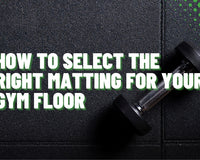When it comes to back day, most people include a rowing movement such as barbell rows or dumbbell rows. But, Gorilla rows are far less common but are worth adding to your library of back-day exercises.
So today we will show you how to master Gorilla rows with our step-by-step guide and what mistakes to avoid.
Plus, we will break down which muscles Gorilla rows target so you know exactly when you should incorporate them into your back-day routine.
What is a Gorilla Row?

The gorilla row is a type of rowing motion that generally involves using kettlebells.
You stand bent over at the hips with your back virtually parallel to the ground. Then with a Kettlebell in each hand, alternately row them up to your belly.
It's a great exercise for training a variety of muscles in your upper back.
Related Post: Deadlift Grips Explained - Which One Should You Use?
What Equipment Do I Need for a Gorilla Row?
To perform Gorilla Rows you only need a pair of Kettlebells. However, if you don't have kettlebells, you can also use dumbbells, or really anything else with a bit of weight to it.
What Muscles Do Gorilla Rows Work?

Gorilla rows are a compound exercise and engage a range of muscles in your arms, back, shoulders and core such as:
- Lats: The rowing motion involves both shoulder adduction and extension, which is where you pull your elbows up towards your torso, and this is great for activating your lats.
- Traps and Rhomboids: When you are doing a gorilla row, your trapezius and rhomboid muscles work together to stabilize and retract the scapula as you pull the weights towards your body.
- Biceps and Forearms: Although these aren't the main muscles worked by the gorilla row, both your biceps and forearms are required to pull the kettle bells up towards your body during the motion and gripping the Kettbells.
- Deltoids: During the rowing motion, your posterior deltoids allow for shoulder extension, which is required for support.
- Erector Spinae: Your erector spinae muscles are required during the gorilla row to help your back stay straight and neutral.
- Core: When you are in a bent over position, you need your core to keep you stable, mainly to prevent rotation.
Overall, as you can see, the gorilla row is an excellent exercise to train your upper body.
Whether you are doing lower reps and going for strength or doing more reps and going for hypertrophy, the gorilla row is an excellent way to train your lats, traps, biceps, deltoids, your core, and more.
Related Post: How to Do Face Pulls?
How to Do a Gorilla Row

Now that we know what the gorilla row is all about, let's go through a quick step by step tutorial on exactly how to do them.
- To do a gorilla row, first start by choosing the kettlebells that you feel the most comfortable with. We recommend starting with 10 or 15 lbs, seeing how it feels, and then going from there.
- Make sure that both kettlebells are of the same weight and put them on the ground right in front of you. Make sure that your feet are wide apart.
- Stand so that your knees are bent just a little bit and that your hips are hinged forward. Your upper body and torso should be virtually parallel with the ground. Make sure to engage your abdominal muscles and core to keep us straight back.
- Hold the kettle bells in a neutral position, which means that your palms should be facing each other.
- Slowly pull one of the kettlebells up towards your belly button while keeping your elbows closely tucked into your sides.
- Hold this position for one or two seconds, and then slowly return the kettlebell back down to its starting position, and when you do so, repeat the movement with the other side.
- Aim to do anywhere between 8 and 15 repetitions per side, and three to five sets.
Mistakes to Avoid When Doing a Gorilla Row
There are a few mistakes you'll want to avoid when doing the gorilla row.
- Don't arch or round your back. Your back should be perfectly straight during this exercise.
- Do not use momentum to force the weight upwards. This should be done in a slow and controlled manner. If you can't lift the weight without momentum, you need to lower the weight.
- Do not flare your elbows out to the sides.
Related Post: What Muscles Do Pull Ups Work?
Alternatives to Gorilla Rows to Build a Stronger Back

If you'd like to create a solid routine to help build strength in your back, there are some other exercises you'll want to add to the mix besides the gorilla row.
These include deadlifts, dumbbell pullovers, inverted rows, chin-ups and pull-ups, tripod rows, and meadows rows.
Related Post: When and Why Should You Use a Weightlifting Belt?
Final Thoughts
Now that you know exactly how to do the gorilla row, you should be well on your way to building a stronger back.





